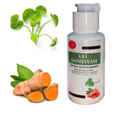The effectiveness of topical gel formulation extract Centella asiatica and Curcuma domestica to fading striae gravidarum

Downloads
Background: The incidence of striae gravidarum in Indonesia is 95%, and 79.7% are primigravida. Striae gravidarum is not a direct physical health risk but is associated with body image and decreased self-confidence. Curcuma domestica contains curcumin and vitamin C, which can stimulate the synthesis of type IV collagen. In contrast, the Centella asiatica plant contains triterpenoids and saponins, which can stimulate the synthesis of type I collagen, which helps regenerate skin cells and improve skin elasticity. However, it is necessary to see the effectiveness of the two herbs, Centella asiatica and Curcuma domestica, in fading striae gravidarum.
Purpose: To prove the effectiveness of topical gel formulation extract Centella asiatica and Curcuma domestica for fading of striae gravidarum.
Methods: This is a quasi-experimental study with a pretest-posttest control group design. The sample consisted of 32 primigravida pregnant women divided into two groups: the intervention group was given a combination of Curcuma domestica and Centella asiatica gel at a dose of 5 mg twice a day for 14 days, and the control group was given a mineral oil gel at a quantity of 5 mg twice a day for 14 days—measurement of striae gravidarum using Davey score. The statistical test used the Friedman and Wilcoxon test.
Results: The average fading of striae gravidarum in the intervention group was more significant than in the control group, 11.44±4.131 to 4±3.033 vs.12.19±5.788 to 8.56±4.320 treatment on the 14th day. The analysis results showed that the topical gel formulation of Centella asiatica and Curcuma domestica was more effective in fading striae gravidarum than the placebo gel (p<0.001).
Conclusion: Administering topical gel containing 12% Centella asiatica extract and a 10% Curcuma domestica dose of 5 mg twice a day for 14 days affected the fading of striae gravidarum.Authors retain copyright and grant the journal right of first publication with the work simultaneously licensed under a Creative Commons Attribution-NonCommercial 4.0 International License that allows others to share the work with an acknowledgement of the work's authorship and initial publication in this journal.
Authors are able to enter into separate, additional contractual arrangements for the non-exclusive distribution of the journal's published version of the work (e.g., post it to an institutional repository or publish it in a book), with an acknowledgement of its initial publication in this journal.
Authors are permitted and encouraged to post their work online (e.g., in institutional repositories or on their website) prior to and during the submission process, as it can lead to productive exchanges, as well as earlier and greater citation of published work (See The Effect of Open Access).

This work is licensed under a Creative Commons Attribution-NonCommercial 4.0 International License.











